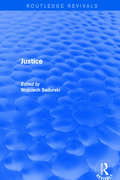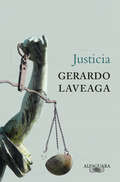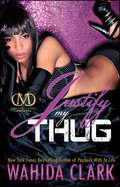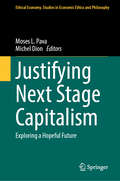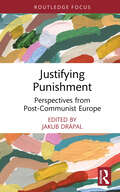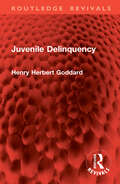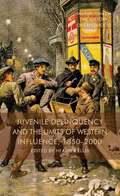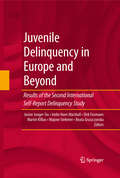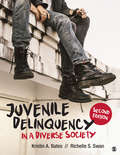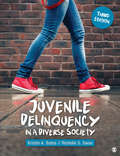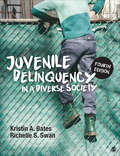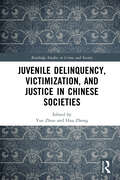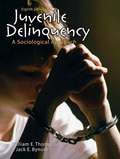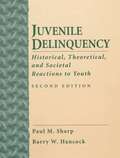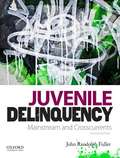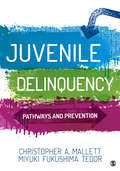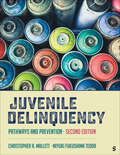- Table View
- List View
Justice: Social Justice And Legal Theory (The\international Library Of Essays In Law And Legal Theory Ser. #2)
by Wojciech SadurskiThis title was first published in 2001. A collection of some of the most significant and influential articles on the theory of justice written from the perspectives of legal theory, ethics, political philosophy and political theory.
Justicia
by Gerardo LaveagaCuando el cuerpo sin vida de una mujer aparece en un lugar público, la autoridad decide acabar con el caso fabricando a un culpable. El cadáver de una joven aparece en un lugar público, justo cuando hay una ceremonia con el jefe de gobierno de la ciudad como actor principal. En la blusa de ella, escrita con pintalabios, se lee la palabra "Puta". Es obvio que ese caso debe resolverse de inmediato, pues arroja oprobio sobre la autoridad. El modo de lograrlo es fabricar a un culpable, un enfermero que, por practicar la eutanasia a su madre, de por sí ya estaba en prisión. El verdadero asesino no les importa a los funcionarios, aunque el lector lo sabrá todo sobre él. Narrada a tres voces, todas impactantes y convincentes, sorpresivos giros argumentales y gran tensión llevan al lector tanto a la angustia de ver cómo los destinos de los personajes van encaminándose al abismo como al conocimiento sistemático de numerosos casos que dan cuenta de la manera de operar del sistema judicial mexicano. Y opera de manera escalofriante: jueces, abogados, ministerio público, corporaciones policiacas, centros de reclusión... todo funciona de manera absurda, aberrante, burocrática, inhumana. La crítica ha dicho... "Como cualquier sátira inteligente -hay que pensar en Swift o Voltaire, como sus modelos-, Justicia también resulta dolorosa. Si se trata de un libro importante, no sólo es por el talento de su autor para el suspense o por la eficacia de sus dardos, sino por su capacidad para incidir en uno de los problemas más urgentes del país". Jorge Volpi. "Una novela de esas que se leen de corrido y con las menores pausas posibles, de las que uno espera que termine la jornada laboral o cualquier otra cosa que uno esté haciendo para poder seguir leyendo las aventuras de sus personajes". Manuel Lino, El Economista.
Justify My Thug: The Thug Series, Book 6 (Thug Series #1)
by Wahida ClarkJustify My Thug continues the scintillating drama of Wahida Clark's bestselling Thug series. Following the action of Thug Lovin', the story rejoins the saga's favorite couple, Tasha and Trae, as they try to overcome their troubles and make their marriage work. Meanwhile, Jaz is facing drama of her own. In the torrid world of sex, drugs, and crime, Wahida Clark continues her definitive Hip-Hop soap opera that fans have come to love.
Justifying Next Stage Capitalism: Exploring a Hopeful Future (Ethical Economy #68)
by Michel Dion Moses L. PavaThis book explores emerging justifications of capitalism based on the views of academics from around the world in business. The traditional justification for capitalism has been that it is the one system that produces the most wealth with the least cost for the most people. While this justification no longer has the taken-for-granted status it once enjoyed, it remains the dominant and mainstream argument in favor of capitalism, especially in the United States. Despite capitalism’s production of human wealth, it is implicated by trends such as income and wealth inequalities, climate change caused by the burning of fossil fuels and racism, sexism and other forms of discrimination. This volume asserts that in this age of complexity, inequality, and ecological instability, capitalism’s future depends on our ability to broaden the justifications for it to include a much more elaborate list of values beyond wealth and efficiency. It does so without claiming tologically or empirically prove that capitalism is the best of all possible economic systems, but rather to explore a new and hopeful future for the system; Next stage capitalism. Written by an international group of scholars from various disciplines, this book is of great interest to those who work in philosophy, sociology, political science, history and theology and religious studies.
Justifying Punishment: Perspectives from Post-Communist Europe (Routledge Contemporary Issues in Criminal Justice and Procedure)
by Jakub DrápalThis book develops principles of proper sentence justification, presents results of comparative empirical study on sentence justifications in the post-communist countries and provides practical measures to improve the current situation. Providing justification for sentences is an essential feature of any sentencing system that strives to achieve principled practice. Principled sentencing requires factors to be considered as well as explained both individually and comprehensively, in a manner that allows the process of determining the sentence to be reviewed and repeated with a similar result. This work determines why reasoning is relevant and provides compelling evidence in favour of an increased role for justification of sentences, grounded in the best sentencing, legal and psychological scholarship. It further explores how various theoretical and practical obstacles might be overcome. Relatedly, it introduces and expands on Schuyt’s novel concept of justifying sentences, which approaches sentence justification in three stages. The authors investigate to what extent these stages are followed in practice in the Czech Republic, Estonia, Moldavia, Slovakia and Slovenia. The results suggest that the quality of sentence justification in these countries is generally low, although there is some variation. The book concludes with suggestions for improving the process and quality of sentence justification. The work will be of interest to those working in the areas of Criminal Law, Criminology, Comparative Law and Legal Philosophy.
Juvenescence: A Cultural History of Our Age
by Robert Pogue HarrisonHow old are you? The more thought you bring to bear on the question, the harder it is to answer. For we age simultaneously in different ways: biologically, psychologically, socially. And we age within the larger framework of a culture, in the midst of a history that predates us and will outlast us. Looked at through that lens, many aspects of late modernity would suggest that we are older than ever, but Robert Pogue Harrison argues that we are also getting startlingly younger--in looks, mentality, and behavior. We live, he says, in an age of juvenescence. Like all of Robert Pogue Harrison's books, "Juvenescence" ranges brilliantly across cultures and history, tracing the ways that the spirits of youth and age have inflected each other from antiquity to the present. Drawing on the scientific concept of neotony, or the retention of juvenile characteristics through adulthood, and extending it into the cultural realm, Harrison argues that youth is essential for culture's innovative drive and flashes of genius. At the same time, however, youth--which Harrison sees as more protracted than ever--is a luxury that requires the stability and wisdom of our elders and the institutions. "While genius liberates the novelties of the future," Harrison writes, "wisdom inherits the legacies of the past, renewing them in the process of handing them down. " A heady, deeply learned excursion, rich with ideas and insights, "Juvenescence" could only have been written by Robert Pogue Harrison. No reader who has wondered at our culture's obsession with youth should miss it.
Juvenile Delinquency (Routledge Revivals)
by Henry Herbert GoddardOriginally published in 1922, Juvenile Delinquency was written while the author was Director of the Ohio Bureau of Juvenile Research. He believed that juvenile delinquency could be prevented and therefore a large part of adult criminality could be eradicated. He states in the preface that the book does not tell you how this will be achieved: ‘It contains no cut and dried solution. But … it may help advertise the fact that there is a small body of people who think they see a ray of light in the darkness. …’. Today it can be read in its historical context.This book is a re-issue originally published in 1922. The language used and views portrayed are a reflection of its era and no offence is meant by the Publishers to any reader by this re-publication.
Juvenile Delinquency and Antisocial Behavior: A Developmental Perspective
by Curt R. Bartol Anne M. BartolTaking a psychological orientation, this book examines the causes, prevention, and intervention of juvenile offending from a contemporary developmental perspective. It looks at how the juvenile offender is influenced by multiple systems within the social environment, issues of resilience and human strength, and strategies for prevention, intervention and treatment. Multicultural perspectives are considered throughout and this edition features more on developmental research, juvenile gangs, and child and adolescent psychopathy. Photos, graphs, tables, and figuresare integrated throughout the book for a visual, easy learning experience.
Juvenile Delinquency and Disability
by Kristin C. Thompson Richard J. MorrisThis book discusses the relationship between juvenile disability and delinquency, including characteristics of youth with disabilities, how disability relates to delinquency, and its impact during a youth's involvement with the juvenile justice system. The book details the relationship between developmental, cognitive, psychological, and educational disorders--specific conditions including ADHD, bipolar disorder, and autism spectrum disorder--and delinquency in light of both their overrepresentation among youth offenders and the uninformed handling of these youth within the court system. Case studies illustrate the complexities in the processing and placement of these youth offenders, as well as highlight the barriers to delinquent youth receiving appropriate treatment, and their increased risk of reoffending. From this robust knowledge base, the authors make expert recommendations for improving the juvenile justice system at the practice and policy levels to better serve this population. This authoritative volume: * Identifies characteristics and risk factors associated with juvenile delinquency. * Reviews evidence relating developmental, mental health, and other disorders to juvenile offending. * Describes the implications of disabilities in key areas such as offending, risk assessment, competency, and outcomes. * Examines the role of disability law in the juvenile justice system. * Offers guidelines for professionals to use this knowledge in their work. Juvenile Delinquency and Disability is an essential resource for researchers, scientist-practitioners, and graduate students in clinical, counseling, and school psychology, criminology and criminal justice, child psychiatry, educational policy and politics, developmental psychology, and social work.
Juvenile Delinquency and the Limits of Western Influence, 1850�2000
by Heather EllisJuvenile Delinquency and the Limits of Western Influence, 1850-2000 brings together a wide range of case studies from across the globe, written by some of the leading scholars in the field, to explore the complex ways in which historical understandings of childhood and juvenile delinquency have been constructed in a global context. The book highlights the continued entanglement of historical descriptions of the development of juvenile justice systems in other parts of the world with narratives of Western colonialism and the persistence of notions of a cultural divide between East and West. It also stresses the need to combine theoretical insights from traditional comparative history with new global history approaches. In doing so, the case studies examined in the volume reveal the significant limitations to the influence of Western ideas about juvenile delinquency in other parts of the world, as well as the important degree to which Western understandings of delinquency were constructed in a transnational context.
Juvenile Delinquency in Europe and Beyond
by Josine Junger-Tas Martin Killias Ineke Haen Marshall Beata Gruszczynska Majone Steketee Dirk EnzmannJuvenile Delinquency in Europe and Beyond: Results of the Second International Self-Report Delinquency Study presents the status of juvenile crime and delinquency and its backgrounds in many of the European Union member states as well as in the United States, Canada, Venezuela and Surinam. The book includes information on key issues in juvenile delinquency such as victimization of young people, alcohol and drug use and its relation to juvenile crime, involvement in youth gangs, immigration, family and school and neighborhood situations. It provides insight into different views on what can be considered juvenile crime; what acts are subsumed in its definition and when we can speak about structural delinquent behavior. These insights are based on self-reported information systematically and simultaneously collected from about 70,000 12-15 year old youths in 28 countries. Until recently, the self-report methodology has not been applied on such a large scale in an international context. The results of this survey provide new and unexpected data about those young people who structurally commit criminal acts, as well as on the frequency of the behavior and the conditions that have an impact on offending. The wealth of descriptions and insights in delinquency of all these countries will be of great interest to scholars, students and practitioners because of the special character of the publication; it is a book of reference to everyone interested in the backgrounds of juvenile delinquency.
Juvenile Delinquency in a Diverse Society
by Dr Kristin Bates Richelle S. SwanJuvenile Delinquency in a Diverse Society, Second Edition presents students with a fresh, critical examination of juvenile delinquency in the context of real communities and social policies—integrating many social factors that shape juvenile delinquency and its control, including race, ethnicity, class, gender, and sexuality. Authors Kristin A. Bates and Richelle S. Swan use true stories and contemporary examples to link theories of delinquency not just to current public policies, but to existing community programs—encouraging readers to consider how theories of delinquency can be used to create new policies and programs in their own communities. Readers will gain a foundational understanding of the social diversity that contextualizes varying experiences and behavior of juvenile delinquency, as well as a deeper appreciation for the policies, social justice, and community programs that make up the juvenile system.
Juvenile Delinquency in a Diverse Society
by Dr Kristin Bates Richelle S. SwanJuvenile Delinquency in a Diverse Society, Second Edition presents students with a fresh, critical examination of juvenile delinquency in the context of real communities and social policies—integrating many social factors that shape juvenile delinquency and its control, including race, ethnicity, class, gender, and sexuality. Authors Kristin A. Bates and Richelle S. Swan use true stories and contemporary examples to link theories of delinquency not just to current public policies, but to existing community programs—encouraging readers to consider how theories of delinquency can be used to create new policies and programs in their own communities. Readers will gain a foundational understanding of the social diversity that contextualizes varying experiences and behavior of juvenile delinquency, as well as a deeper appreciation for the policies, social justice, and community programs that make up the juvenile system.
Juvenile Delinquency in a Diverse Society
by Richelle S. Swan Dr. Kristin A. BatesJuvenile Delinquency in a Diverse Society presents a fresh, critical examination of juvenile delinquency in the context of real communities and social policies— addressing many social factors that shape juvenile delinquency and its control, including race, ethnicity, class, gender, and sexuality. Authors Kristin A. Bates and Richelle S. Swan use true stories and contemporary examples to link theories of delinquency to current public policies and to existing community programs, encouraging readers to consider how theories of delinquency can be used to create new policies and programs in their own communities. The Third Edition includes a new chapter on policing and juveniles, updated scholarship that strengthens the integration of both classic and cutting-edge research, and updates to the book&’s supportive pedagogical features to reflect current events and the experiences of diverse populations of youth.
Juvenile Delinquency in a Diverse Society
by Richelle S. Swan Dr. Kristin A. BatesJuvenile Delinquency in a Diverse Society presents a fresh, critical examination of juvenile delinquency in the context of real communities and social policies— addressing many social factors that shape juvenile delinquency and its control, including race, ethnicity, class, gender, and sexuality. Authors Kristin A. Bates and Richelle S. Swan use true stories and contemporary examples to link theories of delinquency to current public policies and to existing community programs, encouraging readers to consider how theories of delinquency can be used to create new policies and programs in their own communities. The Third Edition includes a new chapter on policing and juveniles, updated scholarship that strengthens the integration of both classic and cutting-edge research, and updates to the book&’s supportive pedagogical features to reflect current events and the experiences of diverse populations of youth.
Juvenile Delinquency in a Diverse Society
by Richelle S. Swan Kristin A. BatesJuvenile Delinquency in a Diverse Society, Fourth Edition presents a fresh, critical examination of juvenile delinquency in the context of real communities and social policies - addressing many social factors that shape juvenile delinquency and its control, including race, ethnicity, class, gender, and sexuality. Authors Kristin A. Bates and Richelle S. Swan use true stories and contemporary examples to link theories of delinquency to current public policies and to existing community programs, encouraging readers to consider how theories of delinquency can be used to create new policies and programs in their own communities.
Juvenile Delinquency in a Diverse Society
by Richelle S. Swan Kristin A. BatesJuvenile Delinquency in a Diverse Society, Fourth Edition presents a fresh, critical examination of juvenile delinquency in the context of real communities and social policies - addressing many social factors that shape juvenile delinquency and its control, including race, ethnicity, class, gender, and sexuality. Authors Kristin A. Bates and Richelle S. Swan use true stories and contemporary examples to link theories of delinquency to current public policies and to existing community programs, encouraging readers to consider how theories of delinquency can be used to create new policies and programs in their own communities.
Juvenile Delinquency, Victimization, and Justice in Chinese Societies (Routledge Studies in Crime and Society)
by Hua Zhong Yue ZhuoExploring the pressing issues of juvenile delinquency, victimization, and justice in Chinese societies, this book showcases contemporary research on these critical topics.The collections provide a comprehensive examination of youth-related challenges and justice systems across mainland China, Hong Kong, Macau, and Taiwan. Featuring contributions from top scholars in the field, the book is presented in three thematic sections – the nature and correlates of juvenile delinquency, the nature and correlates of juvenile victimization, and juvenile justice in Chinese societies. The chapters, applying a variety of mainstream criminological theories, address both persistent and emerging challenges facing Chinese adolescents, such as drug use, sexual offenses, cyberbullying, and victimization among left-behind children. The book enhances the theoretical and empirical understanding of youth delinquency, victimization, and justice within Chinese societies, while advancing the knowledge base in the field and offering valuable insights for future international and comparative research.Contributing to the apprehension of both the applicability and limitation of Western-based criminological theories in the Chinese context, as well as providing a holistic lens to understand the juvenile justice system in China, this book will be of great interest to students and scholars of Criminology, Criminal Justice, Chinese Studies, Asian Studies, Sociology, Social Work, and Law.
Juvenile Delinquency: A Sociological Approach
by William Thompson Jack BynumTaking a sociological approach, this text discusses delinquency as it relates to and emerges from the youth's family, neighborhood, school, peer group, social class, and overall cultural and social environment. The authors incorporate contributions from sociologists, psychologists, social workers, criminologists, and other specialists who have sought to understand, explain, control, and prevent juvenile delinquency.
Juvenile Delinquency: An integrated approach (Criminal Justice Illuminated Ser.)
by Dawn Jeglum Bartusch James BurfeindThis book offers a comprehensive introduction to juvenile delinquency by defining and describing juvenile delinquency, examining explanations for delinquent behavior, and considering contemporary efforts to control delinquency through prevention and juvenile justice. The text cultivates an understanding of juvenile delinquency by examining and linking key criminological theories and research. Coverage includes: the historical origins and transformation of "juvenile delinquency" and juvenile justice; the nature of delinquency, addressing the extent of delinquent offenses, the social correlates of offending and victimization (age, gender, race and ethnicity, and social class), and the developmental patterns of offending; theoretical explanations of delinquency, with insights from biosocial criminology, routine activities, rational choice, social control, social learning, social structure, labeling, and critical criminologies; evidence-based practice in delinquency prevention and contemporary juvenile justice. Fully revised and updated, the new edition incorporates the latest theory and research in the field of juvenile delinquency and provides expanded discussion of contemporary juvenile justice reform, evidence-based practice in delinquency prevention, and disproportionate minority contact throughout the juvenile justice process. This book is essential reading for courses on juvenile delinquency and juvenile justice. The book is supported by a range of compelling pedagogical features. Each chapter includes key terms, learning objectives, an opening case study, box inserts that provide practical application of theory and research, critical thinking questions, suggested reading, useful websites, and a glossary of key terms. A companion website offers an array of resources for students and instructors. For students, this website provides chapter overviews, flashcards of key terms, and useful websites. The instructor site is password protected and offers a complete set of PowerPoint slides and an extensive test bank for each chapter--all prepared by the authors.
Juvenile Delinquency: Historical, Theoretical, and Societal Reactions to Youth
by Paul M. Sharp Barry W. HancockA collection of readings in juvenile delinquency combining historical pieces as well as classic and contemporary theoretical articles. Some of the issues covered include female delinquency, gangs, violence among teens, and societal reactions to youth.
Juvenile Delinquency: Mainstream and Crosscurrents
by John Randolph FullerJuvenile Delinquency: Mainstream and Crosscurrents, Second Edition, is a broad, comprehensive introduction to one of society's most pressing problems. Offering a highly analytical yet balanced approach, the book gets readers thinking critically about important real-world issues including the effects of inequality, race, class, and gender on juvenile delinquency and the justice system. Lively, engaging, and accessible, Juvenile Delinquency is ideal for delinquency courses in both criminal justice and sociology departments.
Juvenile Delinquency: Pathways and Prevention
by Christopher A. Mallett Miyuki Fukushima Tedor"This textbook is an excellent tool that explores issues impacting juvenile delinquency, theories, system response, community interventions, and effective programs to help reduce delinquency." —Robbin Day Brooks, MSW, CPP, Arizona State University’s School of Criminology & Criminal Justice Juvenile Delinquency: Pathways and Prevention explores the pivotal roles that family, trauma, mental health, and schools have on juvenile delinquency, while exploring opportunities for prevention and intervention. Authors Christopher A. Mallett and Miyuki Fukushima Tedor draw from years of experience working with juvenile offenders to shed light on the nature of delinquency and the diverse pathways to juvenile delinquency, while offering evidence-based techniques for preventing and rehabilitating youthful offenders. Clear explanations of the concepts and thought-provoking case studies move students beyond memorization—encouraging them to think critically about juvenile delinquency and make recommendations for better practices and policies. Give your students the SAGE edge! SAGE edge offers a robust online environment featuring an impressive array of free tools and resources for review, study, and further exploration, keeping both instructors and students on the cutting edge of teaching and learning.
Juvenile Delinquency: Pathways and Prevention
by Christopher A. Mallett Miyuki Fukushima Tedor"This textbook is an excellent tool that explores issues impacting juvenile delinquency, theories, system response, community interventions, and effective programs to help reduce delinquency." —Robbin Day Brooks, MSW, CPP, Arizona State University’s School of Criminology & Criminal Justice Juvenile Delinquency: Pathways and Prevention explores the pivotal roles that family, trauma, mental health, and schools have on juvenile delinquency, while exploring opportunities for prevention and intervention. Authors Christopher A. Mallett and Miyuki Fukushima Tedor draw from years of experience working with juvenile offenders to shed light on the nature of delinquency and the diverse pathways to juvenile delinquency, while offering evidence-based techniques for preventing and rehabilitating youthful offenders. Clear explanations of the concepts and thought-provoking case studies move students beyond memorization—encouraging them to think critically about juvenile delinquency and make recommendations for better practices and policies. Give your students the SAGE edge! SAGE edge offers a robust online environment featuring an impressive array of free tools and resources for review, study, and further exploration, keeping both instructors and students on the cutting edge of teaching and learning.
Juvenile Delinquency: Pathways and Prevention
by Christopher A. Mallett Miyuki Fukushima TedorJuvenile Delinquency: Pathways and Prevention, Second Edition explores the pivotal roles that family, trauma, mental health, and schools have on juvenile delinquency, while examining opportunities for prevention and intervention. Authors Christopher A. Mallett and Miyuki Fukushima Tedor draw from years of experience working with juvenile offenders to shed light on the nature of delinquency and the diverse pathways to juvenile delinquency, while offering evidence-based techniques for preventing and rehabilitating youthful offenders. Each chapter features interactive and critical thinking sections alongside special interest boxed features, designed to move students beyond memorization while guiding them to develop informed recommendations for better practices and policies.
